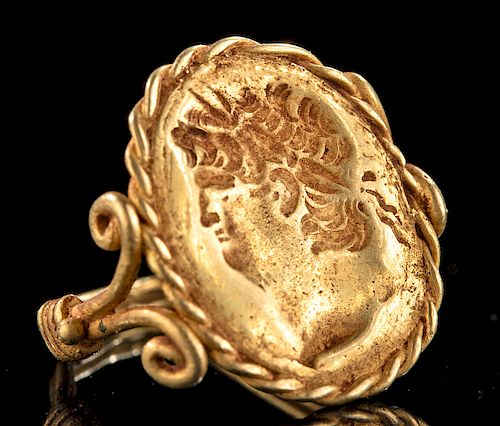Roman 18K+ Gold Ring w/ Nero Portrait
Lot 44
About Seller
Artemis Fine Arts
686 S Taylor Ave, Ste 106
Louisville, CO 80027
United States
Selling antiquities, ancient and ethnographic art online since 1993, Artemis Gallery specializes in Classical Antiquities (Egyptian, Greek, Roman, Near Eastern), Asian, Pre-Columbian, African / Tribal / Oceanographic art. Our extensive inventory includes pottery, stone, metal, wood, glass and textil...Read more
Estimate:
$10,000 - $20,000
Absentee vs Live bid
Two ways to bid:
- Leave a max absentee bid and the platform will bid on your behalf up to your maximum bid during the live auction.
- Bid live during the auction and your bids will be submitted real-time to the auctioneer.
Bid Increments
| Price | Bid Increment |
|---|---|
| $0 | $25 |
| $300 | $50 |
| $1,000 | $100 |
| $2,000 | $250 |
| $5,000 | $500 |
| $10,000 | $1,000 |
| $20,000 | $2,500 |
| $50,000 | $5,000 |
| $100,000 | $10,000 |
| $200,000 | $20,000 |
About Auction
By Artemis Fine Arts
Sep 26, 2019
Set Reminder
2019-09-26 10:00:00
2019-09-26 10:00:00
America/New_York
Bidsquare
Bidsquare : Exceptional Day 1: Antiquities & Asian Art
https://www.bidsquare.com/auctions/artemis-gallery/exceptional-day-1-antiquities-asian-art-4437
Day 1 of an important 2-day auction featuring exceptional, museum-worthy examples of Egyptian, Greek, Etruscan, Roman, Viking, Russian, Near Eastern, as well as Asian Art from China, Japan, Thailand, Vietnam, Burma and India. Artemis Fine Arts info@artemisfinearts.com
Day 1 of an important 2-day auction featuring exceptional, museum-worthy examples of Egyptian, Greek, Etruscan, Roman, Viking, Russian, Near Eastern, as well as Asian Art from China, Japan, Thailand, Vietnam, Burma and India. Artemis Fine Arts info@artemisfinearts.com
- Lot Description
Roman, Imperial Period, ca. 1st century CE. An exceedingly rare gold ring (76% gold, equivalent to 18K+) that presents an intaglio featuring a portrait bust of the infamous Emperor Nero (reign 54-68 CE)with a laurel wreath in his hair. Nero is depicted in profile facing left on the oval table of the ring, surrounded by a twisted rope-patterned border. The delicate shank is comprised of two wires wrapped by additional gold wire accented with a granule and resolving in two curled termini on each side. US ring size: 3. Size: oval table measures .7" L x .625" W (1.8 cm x 1.6 cm); opening measures .77" L x .625" W (2 cm x 1.6 cm); weight: 3.5 grams; gold quality: 76% gold, equivalent to 18K+
Nero was the final Roman emperor of the Julio-Claudian line. He became emperor in 54 CE, at the age of sixteen, making him the youngest sole emperor until Elagabalus, who became emperor at 14 in 218 CE. Nero's rule is usually associated with tyranny and extravagance - rumored to have played a lyre while Rome was burning in the Great Fire; however, some sources point to his popularity among the commoners living in the eastern provinces of the Empire - and despite his tyrannical reputation, perhaps we can appreciate the fact that Nero was an art lover who is said to have performed music and recited poetry to the senate as well as the populace.
The image of Nero on this ring is similar to those found on ancient Roman gold coins, ca. 54-68. See this example in the British Museum - https://www.britishmuseum.org/research/collection_online/collection_object_details.aspx?objectId=1216029&partId=1
Provenance: private Keller collection inherited from his grandfather's ex-Toro, Spain collection from the 1940s
All items legal to buy/sell under U.S. Statute covering cultural patrimony Code 2600, CHAPTER 14, and are guaranteed to be as described or your money back.
A Certificate of Authenticity will accompany all winning bids.
We ship worldwide and handle all shipping in-house for your convenience.
#148805Indentations to the shank. Red deposits due to exposure to iron rich soil. Slight age wear to the table but the portrait bust is remarkably well preserved.Condition
- Shipping Info
-
All shipping is handled in-house for your convenience. Your invoice from Artemis Gallery will include shipping calculation instructions. If in doubt, please inquire BEFORE bidding for estimated shipping costs for individual items.
-
- Buyer's Premium



 EUR
EUR CAD
CAD AUD
AUD GBP
GBP MXN
MXN HKD
HKD CNY
CNY MYR
MYR SEK
SEK SGD
SGD CHF
CHF THB
THB













